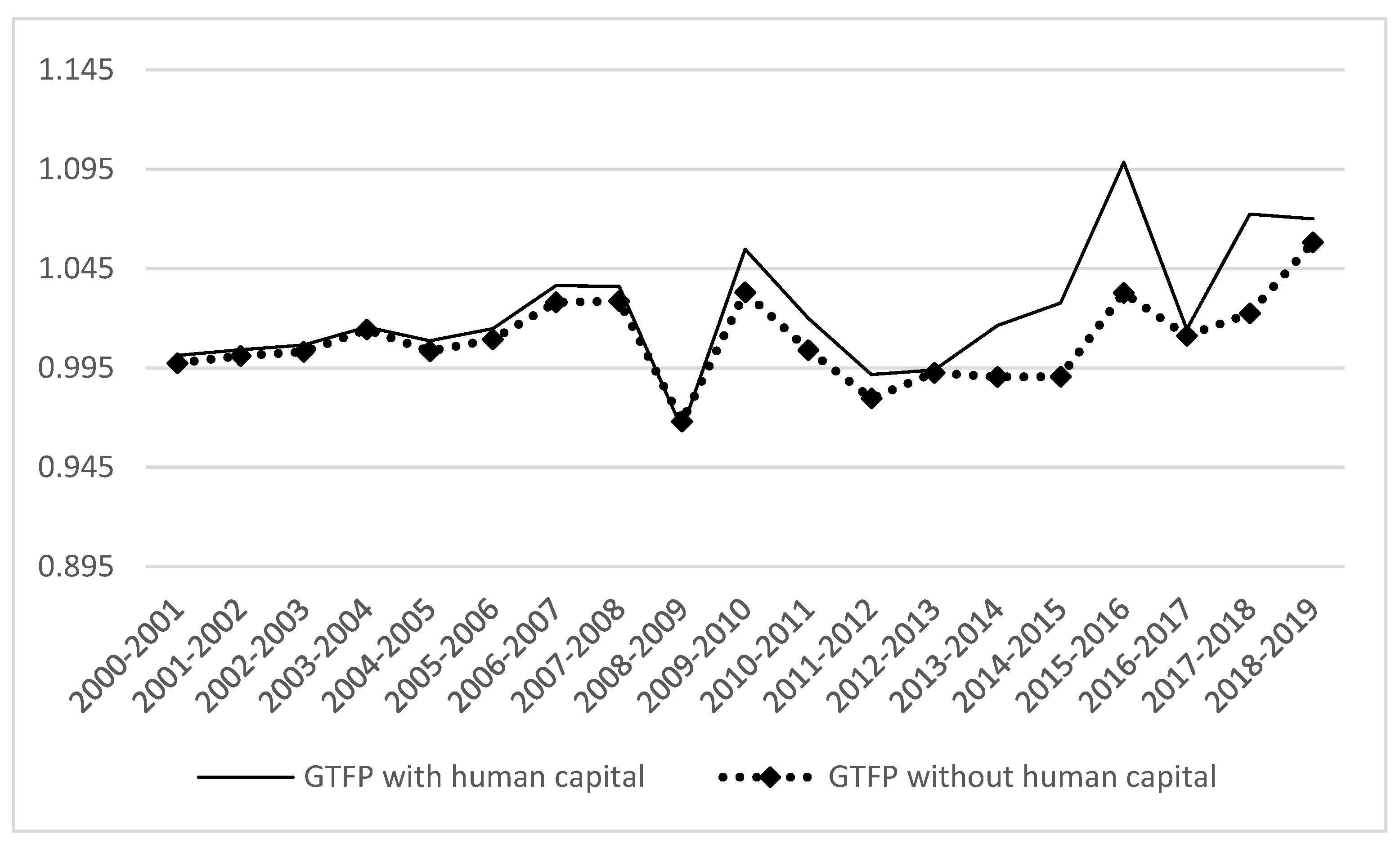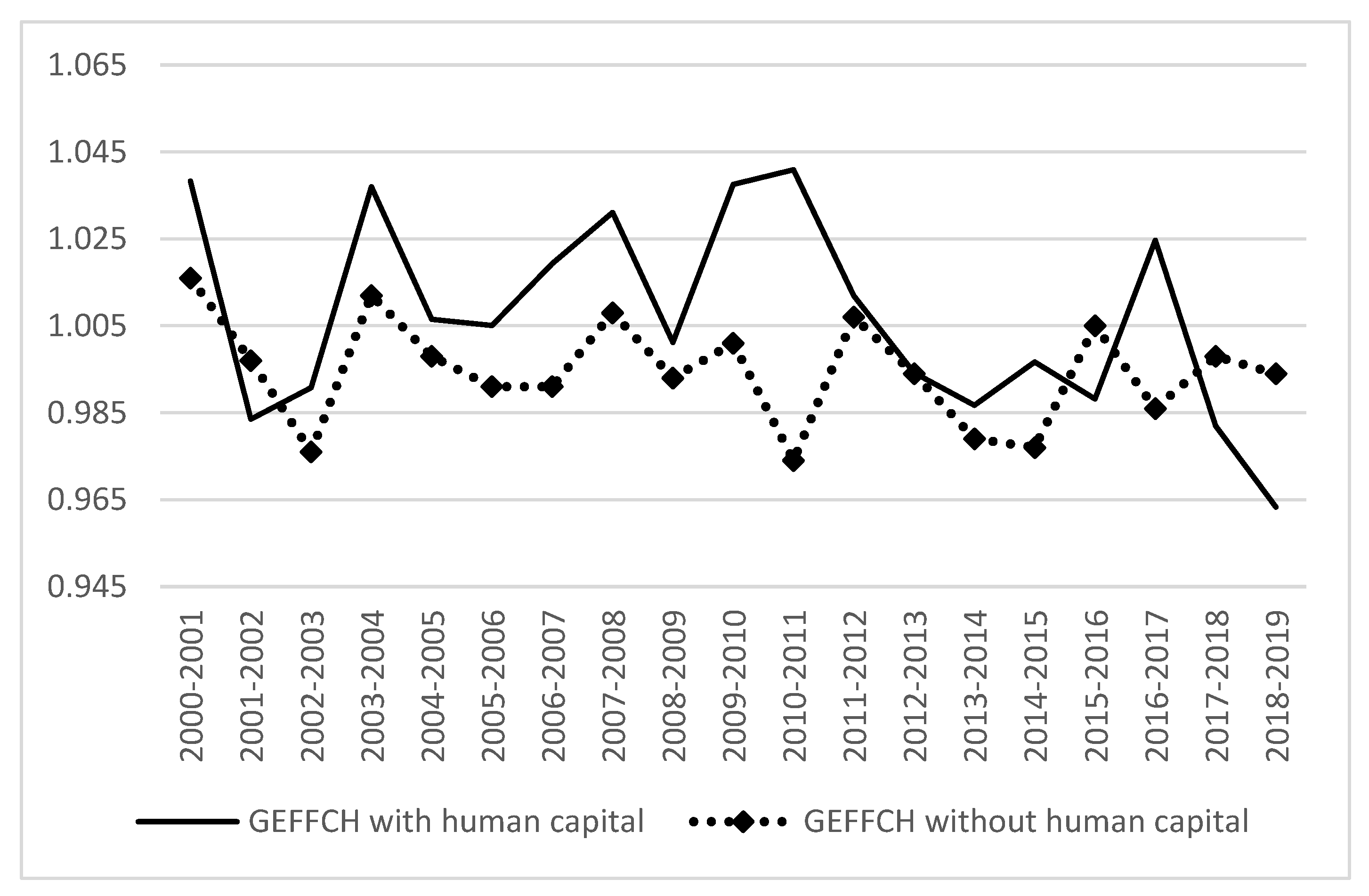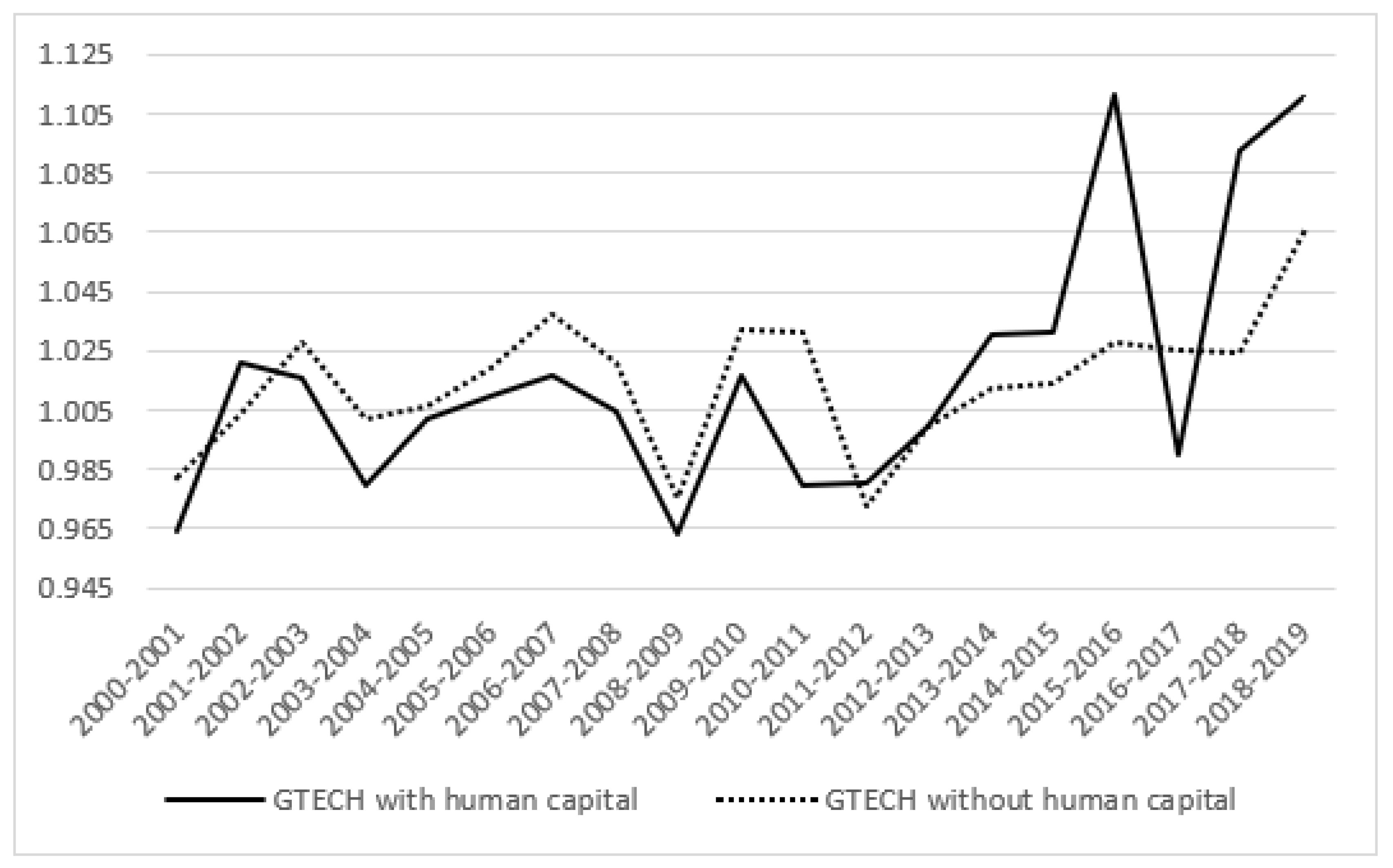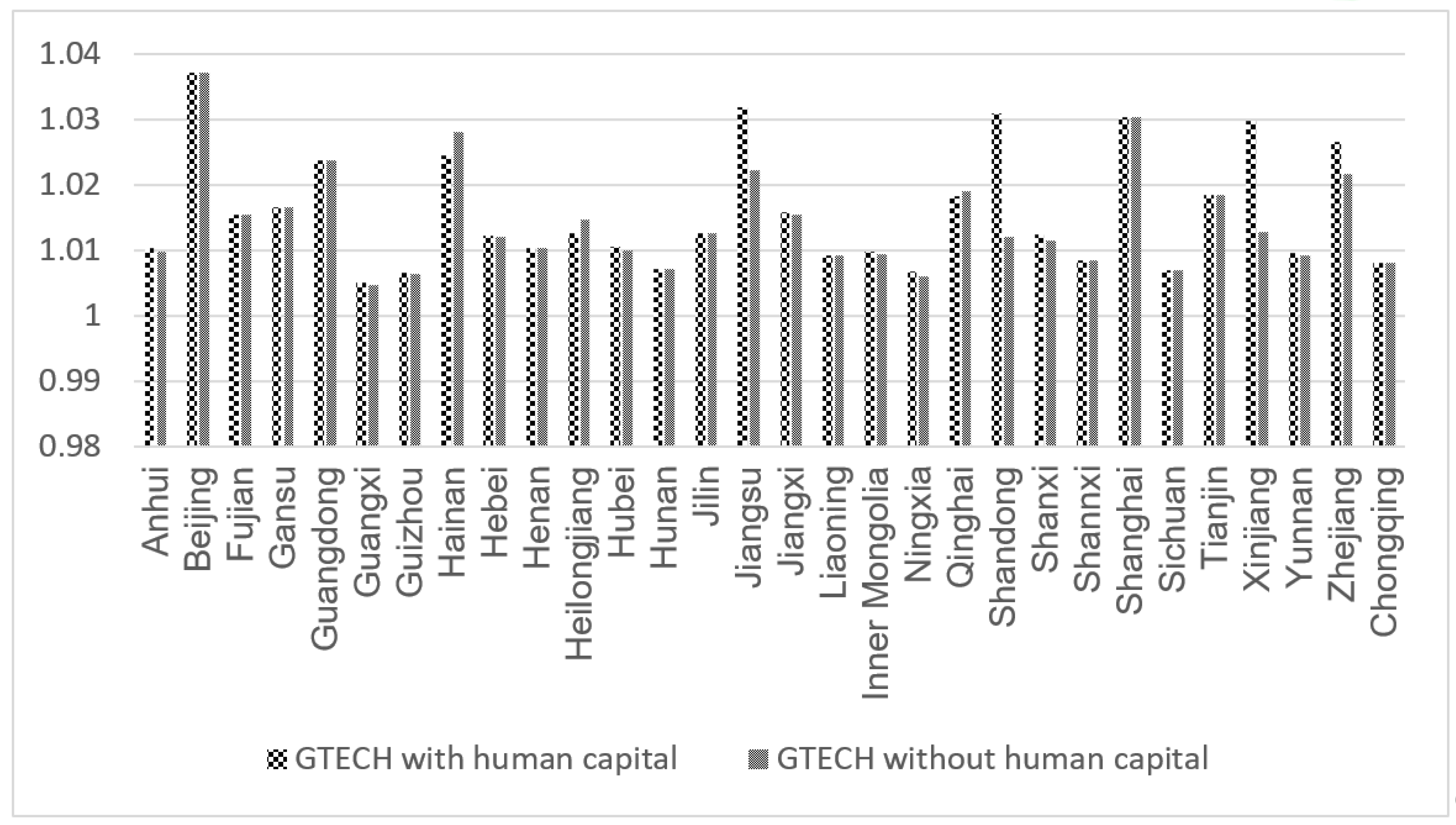Measurement of China’s Green Total Factor Productivity Introducing Human Capital Composition
Abstract
1. Introduction
2. Literature Review
2.1. Measurement of Human Capital
2.2. Measurement of GTFP
2.3. Relationship between Human Capital and GTFP
3. Model and Data Description
3.1. SBM-GML Model
3.1.1. Global Production Possibility Set
3.1.2. SBM Model
3.1.3. GML Index
3.2. Selection of Variables
3.2.1. Input Variables
- Labor. Since this paper considers human capital composition, it is necessary to distinguish between labor quantity and quality, and the quality includes education, health, scientific research, and training. (1) Labor quantity. Similar to most studies, this paper uses the total number of employees engaged in social labor and paid at year-end to represent labor quantity. (2) Education. This paper uses average years of education as a proxy for education human capital, which is generally expressed by the product of the proportion of educated labor at all levels and education years. According to Thomas et al. (2001), we divide the education level into seven grades: illiterate, primary school, junior high school, high school and secondary vocational school, college, undergraduate, postgraduate, and above [58]. In this way, the calculation formula of average years of education can be expressed as , where i is the education level, denotes proportion of educated labor at all levels, denotes cumulative years of education corresponding to each education level, which is respectively set as 0, 6, 9, 12, 15, 16, and 20 (Table 1) [59,60]. (3) Health. A higher proportion of government health expenditure can cultivate more healthy human capital, so we use the proportion of total health expenditure in gross domestic product (GDP) as a proxy for health. (4) Scientific research. The research and development (R&D) personnel full-time equivalent is an internationally accepted indicator for comparing scientific and technical manpower inputs, so it is taken as the proxy of scientific research human capital in this paper. (5) Training. Considering the availability of data, based on the “Decision” promulgated in 2002, this paper adopts 1.5% of the employee’s gross salary to represent the human capital used for training.
- Capital. Capital input is represented by fixed capital stock, which is calculated by the perpetual inventory method: . denotes the physical capital stock of region i in period t, denotes the total investment in fixed assets at the current price of region i in period t, denotes the price index of the total investment in fixed assets. is the depreciation rate, which is set at 9.6% [61].
3.2.2. Output Variables
- Desired output. This paper chooses regional GDP to represent the desired output. The annual regional GDP recorded in the Statistical Yearbook is estimated at current prices, but inflation will cause price changes, so it is necessary to eliminate the price factor. This paper takes 1978 as the base period and uses the GDP deflator to subtract the original data for obtaining the GDP per year, expressed at constant prices in 1978.
- Undesired output. Considering the current industrial three wastes (exhaust gas, waste water, and solid waste) in the process of Chinese industrialization, this paper adopts three types of domestic and industrial pollutant emissions as the proxy variable of undesired output: (1) Chemical oxygen demand (COD) emissions; (2) Sulfur dioxide (SO2) emissions; (3) Solid waste emissions. Due to the lack of emission data for solid waste, we take the production of solid waste as a substitute to obtain effective and robust econometric regression results.
3.3. Data Source and Description
4. Empirical Results and Discussion
4.1. Empirical Results
4.1.1. Temporal Variation Characteristics
4.1.2. Regional Distribution Characteristics
4.1.3. Compared with the Measurement Results without Human Capital
- Comparison of GTFP in Two Modes.
- 2.
- Comparison of the Decomposition of GTFP in Two Modes.
4.2. Discussion
5. Conclusions
- The GTFP measured based on human capital composition shows a fluctuating growth trend, with an average annual growth rate of 2.31%, which indicates that the efficiency of green growth has been improved across the country, the growth momentum is sufficient, and the economic growth mode is sustainable. Therefore, the improvement of human capital is an important means by which to achieve green economic development, and it is necessary to further increase the investment in human capital. The government should continue to strengthen the investment in education and the construction of medical and health security to ensure the necessary foundation for the improvement of human capital.
- From the decomposition of GTFP, technological progress (1.59%) is the main driving force, and technical efficiency improvement (0.71%) is the secondary driving force; that is, the national average GTFP growth from 2000 to 2019 showed a joint promotion of “dual-drive” growth model. This means that, with the improvement of human capital in education, health, scientific research, and training, the ability for scientific and technological innovation is enhanced, and technological progress is rapidly developing.
- The measurement results of China’s GTFP based on human capital composition are generally higher than that without human capital composition, and the growth of GTFP in both models presents a trend of “high in the east and low in the west”. Therefore, regions with high level of GTFP should play a leading role in promoting regional collaborative development by weakening the “siphon effect” between regions, emphasizing the radiation of human capital from “center” to “edge”, and strengthening green technology exchange and cooperation. In terms of decomposition, technological progress is the main factor promoting the growth of GTFP, while efficiency improvement has no positive effect on the GTFP without human capital.
Author Contributions
Funding
Institutional Review Board Statement
Informed Consent Statement
Data Availability Statement
Conflicts of Interest
References
- Zhang, J. Delivering environmentally sustainable economic growth: The case of China. Asia Soc. Rep. 2012, 2–25. [Google Scholar]
- World Health Organization. WHO Report on Cancer: Setting Priorities, Investing Wisely and Providing Care for All; World Health Organization: Geneva, Switzerland, 2020. [Google Scholar]
- Nanere, M.; Fraser, I.; Quazi, A.; D’Souza, C. Environmentally adjusted productivity measurement: An Australian case study. J. Environ. Manag. 2007, 85, 350–362. [Google Scholar] [CrossRef] [PubMed]
- Chen, S.Y. Green industrial revolution in China: A perspective from the change of environmental total factor productivity. Econ. Res. 2010, 45, 21–34+58. [Google Scholar]
- Liu, Z.; Xin, L. Has China’s Belt and road initiative promoted its green total factor productivity? Evidence from primary provinces along the route. Energy Policy. 2019, 129, 360–369. [Google Scholar] [CrossRef]
- Hailu, A.; Veeman, T.S. Non-parametric productivity analysis with undesirable outputs: An application to the Canadian pulp and paper industry. Am. J. Agric. Econ. 2001, 83, 605–616. [Google Scholar] [CrossRef]
- Ramanathan, R. An analysis of energy consumption and carbon dioxide emissions in countries of the Middle East and North Africa. Energy 2005, 30, 2831–2842. [Google Scholar] [CrossRef]
- Chen, S.Y. Energy consumption, CO2 emission and sustainable development in Chinese industry. Econ. Res. 2009, 44, 41–55. [Google Scholar]
- Chung, Y.H.; Färe, R.; Grosskopf, S. Productivity and undesirable outputs: A directional distance function approach. J. Environ. Manag. 1997, 51, 229–240. [Google Scholar] [CrossRef]
- Watanabe, M.; Tanaka, K. Efficiency analysis of Chinese industry: A directional distance function approach. Energy Policy 2007, 35, 6323–6331. [Google Scholar] [CrossRef]
- Wang, B.; Wu, Y.R.; Yan, P.F. Environmental efficiency and environmental total factor productivity growth in China’s regional economies. Econ. Res. J. 2010, 45, 95–109. [Google Scholar]
- Edziah, B.K.; Sun, H.; Anyigbah, E.; Li, L. Human capital and energy efficiency: Evidence from developing countries. Am. J. Ind. Bus. Manag. 2021, 11, 599–610. [Google Scholar] [CrossRef]
- Mubarik, M.S.; Naghavi, N. Quest for energy efficiency: The role of human capital and firm internationalization. Energy-Growth Nexus Era Glob. 2022, 31–322. [Google Scholar] [CrossRef]
- Tsai, C.L.; Hung, M.C.; Harriott, K. Human capital composition and economic growth. Soc. Indic. Res. 2010, 99, 41–59. [Google Scholar] [CrossRef]
- Wang, M.; Xu, M.; Ma, S. The effect of the spatial heterogeneity of human capital structure on regional green total factor productivity. Struct. Chang. Econ. Dyn. 2021, 59, 427–441. [Google Scholar] [CrossRef]
- Jin, W.; Gao, S.H.; Pan, S.F. Research on the impact mechanism of environmental regulation on green total factor productivity from the perspective of innovative human capital. Environ. Sci. Pol. Res. 2022, 1–19. [Google Scholar] [CrossRef]
- Schultz, T.W. Investment in human capital. Am. Econ. Rev. 1961, 51, 1–17. [Google Scholar]
- Engel, E. Der Werth des Menschen; Verlag von Leonhard Simion: Berlin, Germany, 1883. [Google Scholar]
- Kendrick, J.W. The Formation and Stocks of Total Capital; NBER Books: New York, NY, USA, 1976. [Google Scholar]
- Kendrick, J.W. Total capital and economic growth. Atl. Econ. J. 1994, 22, 1–18. [Google Scholar] [CrossRef]
- Qian, X.Y.; Liu, J. The experimental research of the level of human capital of China. Stat. Res. 2004, 3, 39–45. [Google Scholar] [CrossRef]
- Zhang, Z.J.; Zhao, H.Z. The estimation on human capital stock of China. Stat. Res. 2012, 29, 41–45. [Google Scholar] [CrossRef]
- Barro, R.J.; Lee, J.W. International comparisons of educational attainment. J. Monet. Econ. 1993, 32, 363–394. [Google Scholar] [CrossRef]
- Lai, M.Y.; Zhang, X.; Peng, S.J.; Bao, Q. The source of economic growth: Human capital, R&D and technical spillovers. Soc. Sci. China 2005, 2, 32–46+204–205. [Google Scholar]
- Romer, P.M. Human Capital and Growth: Theory and Evidence. Car.-Roch. Con. Se. Pub. Pol. 1990, 32, 251–286. [Google Scholar] [CrossRef]
- Wang, Y.; Yao, Y.D. Sources of China’s economic growth 1952–1999: Incorporating human capital accumulation. China Econ. Rev. 2003, 14, 32–52. [Google Scholar] [CrossRef]
- Jorgenson, D.W.; Fraumeni, B.M. The Output of the Education Sector. Output Measurement in the Service Sectors; University Chicago Press: Chicago, IL, USA, 1992; pp. 303–341. [Google Scholar]
- Zhu, P.F.; Xu, D.F. The estimation of human capital in Chinese cities. Econ. Res. J. 2007, 9, 84–95. [Google Scholar]
- Solow, R.M. The Economics of Resources or the Resources of Economics; Classic papers in natural resource economics; Palgrave Macmillan: London, UK, 1974; pp. 257–276. [Google Scholar] [CrossRef]
- Tu, Z.; Zhou, T.; Zhang, N. Does China’s pollution levy standards reform promote green growth? Sustainability 2019, 11, 6186. [Google Scholar] [CrossRef]
- Hou, S.Y.; Song, L.R. Market integration and regional green total factor productivity: Evidence from China’s province-level data. Sustainability 2021, 13, 472. [Google Scholar] [CrossRef]
- Tone, K. A slacks-based measure of efficiency in data envelopment analysis. Eur. J. Opera Res. 2001, 130, 498–509. [Google Scholar] [CrossRef]
- Fukuyama, H.; Weber, W.L. A directional slacks-based measure of technical inefficiency. Soc. Econ. Plann. Sci. 2009, 43, 274–287. [Google Scholar] [CrossRef]
- Wang, Y.; Xie, L.; Zhang, Y.; Wang, C.; Yu, K. Does FDI promote or inhibit the high-quality development of agriculture in China? An agricultural GTFP perspective. Sustainability 2019, 11, 4620. [Google Scholar] [CrossRef]
- Li, Y.; Chen, Y. Development of an SBM-ML model for the measurement of green total factor productivity: The case of pearl river delta urban agglomeration. Renew. Sustain. Energy Rev. 2021, 145, 111131. [Google Scholar] [CrossRef]
- Ding, L.; Wu, M.; Jiao, Z.; Nie, Y. The positive role of trade openness in industrial green total factor productivity—Provincial evidence from China. Environ. Sci. Pollut. Res. 2022, 29, 6538–6551. [Google Scholar] [CrossRef] [PubMed]
- Oh, D. A global Malmquist-Luenberger productivity index. J. Prod. Anal. 2010, 34, 183–197. [Google Scholar] [CrossRef]
- Wang, M.; Feng, C. Revealing the pattern and evolution of global green development between different income groups: A global meta-frontier by-production technology approach. Environ. Impact Assess. Rev. 2021, 89, 106600. [Google Scholar] [CrossRef]
- Wu, Z.; Zeng, C.; Huang, W.; Chen, S. Convergence of green total factor productivity in China’s service industry. Environ. Sci. Pol. Res. 2022, 1–16. [Google Scholar] [CrossRef]
- Benhabib, J.; Spiegel, M. The role of human capital in economic development evidence from aggregate cross-country data. J. Monet. Econ. 1994, 34, 143–173. [Google Scholar] [CrossRef]
- Caselli, F.; Coleman, W.J., II. The world technology frontier. Am. Econ. Rev. 2006, 96, 499–522. [Google Scholar] [CrossRef]
- Simon, C.J.; Nardinelli, C. Human capital and the rise of American cities, 1900–1990. Reg. Sci. Urban Econ. 2002, 32, 59–96. [Google Scholar] [CrossRef]
- Cerver-Romero, E.; Ferreira, J.J.; Fernandes, C. A scientometric analysis of knowledge spillover research. J. Technol. Transf. 2020, 45, 780–805. [Google Scholar] [CrossRef]
- Hou, Y.F.; Wang, J.Y. Human capital and transition in mode of economic. Popul. Res. 2001, 25, 13–19. [Google Scholar]
- Ramos, R.; Surinach, J.; Artís, M. Regional economic growth and human capital: The role of over-education. Reg. Stud. 2012, 46, 1389–1400. [Google Scholar] [CrossRef]
- Bano, S.; Zhao, Y.; Ahmad, A.; Wang, S.; Liu, Y. Identifying the impacts of human capital on carbon emissions in Pakistan. J. Clean. Prod. 2018, 183, 1082–1092. [Google Scholar] [CrossRef]
- Chen, G.S.; Hu, J.X. The impact of human capital accumulation on environmental quality. Urban Probl. 2019, 10, 46–52. [Google Scholar] [CrossRef]
- Tan, Z.; Wang, X.Y. Empirical study on green TFP provincial spatial learning effect. China Popul. Resour. Environ. 2016, 26, 17–24. [Google Scholar]
- Zhu, J.H.; Wang, Y.L. Estimation of green total factor productivity and the influencing factors—An empirical verification based on dynamic GMM method. J. Xinjiang Univ. 2019, 2, 1–15. [Google Scholar] [CrossRef]
- Yin, Q.; Li, Z.W. How does innovation spillover affect the total factor productivity of China’s inter-provincial environment—An empirical analysis based on DEA-ESDA method. Sci. Tech. Prog. Pol. 2019, 36, 45–54. [Google Scholar]
- Zhang, W.; Hu, Y. A study on the effect mechanism of human capital on economic growth in the Yangtze River delta—Based on the mediating effect of innovation. J. Anhui Univ. 2021, 45, 124–136. [Google Scholar] [CrossRef]
- Su, K.; Zhou, C. Human capital, technological innovation and green total factor productivity: Based on the data Analysis of cities in the Yangtze River economic belt. On Econ. Prob. 2021, 5, 71–79. [Google Scholar] [CrossRef]
- Gu, W.T.; Wang, J.Y.; Hua, X.Y.; Liz, Z.D. Entrepreneurship and high-quality economic development: Based on the triple bottom line of sustainable development. Int. Entrep. Manag. J. 2021, 17, 1–27. [Google Scholar] [CrossRef]
- Gu, W.T.; Wang, J.Y. Research on index construction of sustainable entrepreneurship and its impact on economic growth. J. Bus. Res. 2022, 142, 266–276. [Google Scholar] [CrossRef]
- Zhang, S.F.; Chen, C.C.; Huang, D.H.; Hu, L. Measurement of factor price distortion: A new production function method with time-varying elasticity. Technol. Forecast. Soc. Chang. 2022, 175, 121363. [Google Scholar] [CrossRef]
- Zhang, S.F.; Liu, Y.X.; Huang, D.H. Understanding the mystery of continued rapid economic growth. J. Bus. Res. 2021, 124, 529–537. [Google Scholar] [CrossRef]
- Zhang, S.F.; Luo, J.Y.; Huang, D.H.; Xu, J.J. Market distortion, factor misallocation, and efficiency loss in manufacturing enterprises. J. Bus. Res. 2023, 154, 113290. [Google Scholar] [CrossRef]
- Thomas, V.; Wang, Y.; Fan, X. Measuring Education Inequality: Gini Coefficients of Education; World Bank Publications: Washington, DC, USA, 2001. [Google Scholar]
- Zhang, S.Y.; Liu, C.C. Study on relationship between wages income and level of education of farmers. Sci. Technol. Econ. 2009, 22, 51–54. [Google Scholar]
- Fang, C.; Luo, Y.Z. Reform of the supply side of China’s graduate level of education: From the perspective of the gradient of human capital. Tsing. J. Edu. 2016, 37, 68–77. [Google Scholar] [CrossRef]
- Zhang, J.; Wu, G.Y.; Zhang, J.P. The estimation of China’s provincial capital stock: 1952—2000. Econ. Res. 2004, 10, 35–44. [Google Scholar]
- Li, L.B.; Liu, B.L. Source identification and dynamic evolution of regional economic growth performance in China: Based on input-level decomposition. Econ. Res. J. 2015, 50, 58–72. [Google Scholar]
- Zheng, J.; Hu, A. An empirical analysis of provincial productivity in China (1979–2001). J. Chin. Econ. Bus. Stud. 2006, 4, 221–239. [Google Scholar] [CrossRef][Green Version]
- Yue, S.J.; Liu, C.M. Human capital accumulation and regional total factor productivity. Econ. Res. 2006, 4, 90–96. [Google Scholar]







| Level | Education Level | Years of Education | Cumulative Years of Education |
|---|---|---|---|
| 1 | Illiterate | 0 | 0 |
| 2 | Primary school | 6 | 6 |
| 3 | Junior high school | 3 | 9 |
| 4 | High school and secondary vocational school | 3 | 12 |
| 5 | Senior college | 3 | 15 |
| 6 | Undergraduate | 4 | 16 |
| 7 | Postgraduate and above | 3 | 20 |
| First Grade Indicators | Second Grade Indicators | Indicator Descriptions |
|---|---|---|
| Input | Education | Average years of education |
| Health | The proportion of total health expenditure in GDP | |
| Scientific research | R&D personnel full-time equivalent | |
| Training | 1.5% of the employee’s gross salary | |
| Capital | Fixed capital stock | |
| Labor quantity | Number of employees | |
| Energy | Total energy consumption | |
| Desired output | GDP | Real GDP of each region based on the year 1978 |
| COD emissions | Including domestic and industrial pollution | |
| Undesired output | SO2 emissions | |
| Solid waste productions |
| Variable | Mean | Med | Sd | Min | Max |
|---|---|---|---|---|---|
| Education (year) | 9.2066 | 9.0999 | 1.3249 | 5.934 | 13.997 |
| Health (%) | 5.4136 | 5.075 | 1.6688 | 2.64 | 11.97 |
| Scientific research (ten thousand people a year) | 84,553.155 | 47,506.5 | 109,321.5902 | 848 | 803,208 |
| Training (hundred million yuan) | 5.4754 | 4.0797 | 3.4439 | 0.7463 | 16.0052 |
| Capital (hundred million yuan) | 9030.689 | 5472.316 | 10,424.26 | 212.876 | 71,974 |
| Labor quantity (ten thousand people) | 2543.0582 | 2060.95 | 1696.5404 | 275.5 | 7072.625 |
| Energy (tons of standard coal) | 11,517.5554 | 9292.5 | 8155.3163 | 480 | 41,390 |
| GDP (hundred million yuan) | 15,300.477 | 10,093.16 | 16,753.87 | 263.68 | 110,184.54 |
| COD emissions (ten thousand tons) | 49.8761 | 39.44669 | 37.32154 | 1.9677 | 198.2 |
| SO2 emissions (ten thousand tons) | 62.6716 | 53.42 | 44.5431 | 0.19 | 200.3 |
| Solid waste productions (ten thousand tons) | 7916.4448 | 5468 | 8218.0186 | 75 | 52,037 |
| Region | Province | GEFFCH | GTECH | GTFP |
|---|---|---|---|---|
| Eastern | Beijing | 1.0000 | 1.0371 | 1.0371 |
| Tianjin | 1.0129 | 1.0184 | 1.0315 | |
| Hebei | 1.0111 | 1.0123 | 1.0235 | |
| Liaoning | 1.0005 | 1.0092 | 1.0097 | |
| Shanghai | 1.0000 | 1.0304 | 1.0304 | |
| Jiangsu | 1.0000 | 1.0318 | 1.0318 | |
| Zhejiang | 1.0000 | 1.0266 | 1.0266 | |
| Fujian | 1.0000 | 1.0155 | 1.0155 | |
| Shandong | 1.0000 | 1.0309 | 1.0309 | |
| Guangdong | 1.0000 | 1.0237 | 1.0237 | |
| Guangxi | 1.0259 | 1.0051 | 1.0311 | |
| Hainan | 1.0000 | 1.0246 | 1.0246 | |
| Central | Shanxi | 1.0074 | 1.0125 | 1.0200 |
| Inner Mongolia | 1.0231 | 1.0097 | 1.0330 | |
| Jilin | 1.0177 | 1.0126 | 1.0305 | |
| Heilongjiang | 1.0123 | 1.0126 | 1.0250 | |
| Anhui | 1.0023 | 1.0103 | 1.0126 | |
| Jiangxi | 0.9973 | 1.0158 | 1.0131 | |
| Henan | 1.0197 | 1.0104 | 1.0303 | |
| Hubei | 1.0083 | 1.0105 | 1.0189 | |
| Hunan | 1.0162 | 1.0071 | 1.0235 | |
| Western | Chongqing | 1.0197 | 1.0081 | 1.0280 |
| Sichuan | 1.0241 | 1.0070 | 1.0313 | |
| Guizhou | 1.0051 | 1.0066 | 1.0116 | |
| Yunnan | 1.0056 | 1.0096 | 1.0152 | |
| Shaanxi | 1.0042 | 1.0085 | 1.0127 | |
| Gansu | 0.9964 | 1.0166 | 1.0129 | |
| Ningxia | 1.0021 | 1.0068 | 1.0089 | |
| Qinghai | 1.0012 | 1.0183 | 1.0196 | |
| Xinjiang | 1.0000 | 1.0299 | 1.0299 |
| Region | GTFP with Human Capital | GTFP without Human Capital |
|---|---|---|
| Eastern | 1.0263 | 1.0128 |
| Central | 1.0230 | 1.0062 |
| Western | 1.0189 | 1.0056 |
| Region | Including Human Capital | without Human Capital | ||
|---|---|---|---|---|
| Efficiency Variation | Technology Progress | Efficiency Variation | Technology Progress | |
| National | 1.0071 | 1.0159 | 0.994 | 1.014 |
| Eastern | 1.0042 | 1.0221 | 0.9934 | 1.0196 |
| Central | 1.0116 | 1.0113 | 0.9951 | 1.0112 |
| Western | 1.0065 | 1.0124 | 0.9952 | 1.0104 |
Publisher’s Note: MDPI stays neutral with regard to jurisdictional claims in published maps and institutional affiliations. |
© 2022 by the authors. Licensee MDPI, Basel, Switzerland. This article is an open access article distributed under the terms and conditions of the Creative Commons Attribution (CC BY) license (https://creativecommons.org/licenses/by/4.0/).
Share and Cite
Cheng, C.; Yu, X.; Hu, H.; Su, Z.; Zhang, S. Measurement of China’s Green Total Factor Productivity Introducing Human Capital Composition. Int. J. Environ. Res. Public Health 2022, 19, 13563. https://doi.org/10.3390/ijerph192013563
Cheng C, Yu X, Hu H, Su Z, Zhang S. Measurement of China’s Green Total Factor Productivity Introducing Human Capital Composition. International Journal of Environmental Research and Public Health. 2022; 19(20):13563. https://doi.org/10.3390/ijerph192013563
Chicago/Turabian StyleCheng, Can, Xiuwen Yu, Heng Hu, Zitian Su, and Shangfeng Zhang. 2022. "Measurement of China’s Green Total Factor Productivity Introducing Human Capital Composition" International Journal of Environmental Research and Public Health 19, no. 20: 13563. https://doi.org/10.3390/ijerph192013563
APA StyleCheng, C., Yu, X., Hu, H., Su, Z., & Zhang, S. (2022). Measurement of China’s Green Total Factor Productivity Introducing Human Capital Composition. International Journal of Environmental Research and Public Health, 19(20), 13563. https://doi.org/10.3390/ijerph192013563






